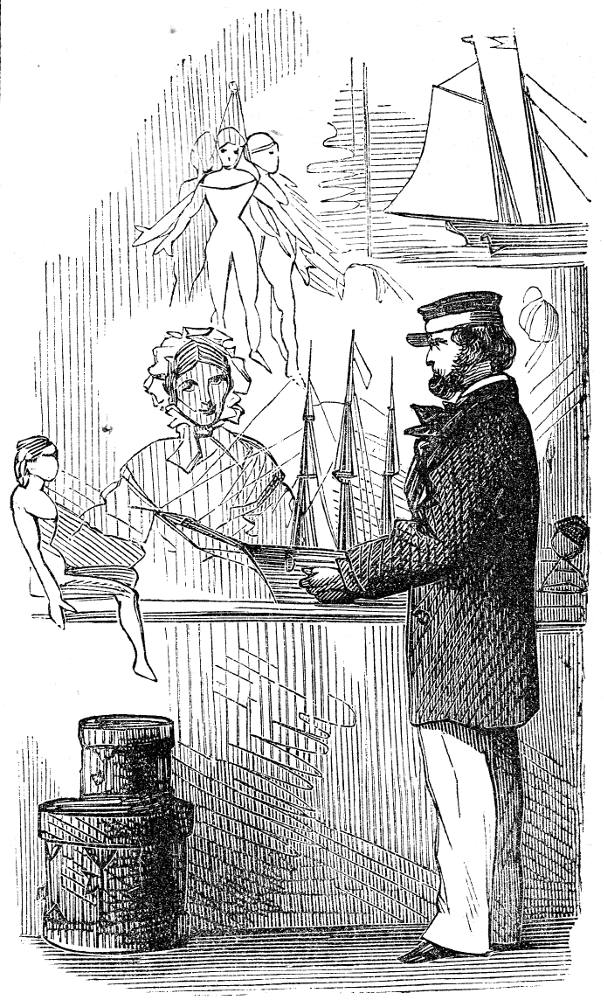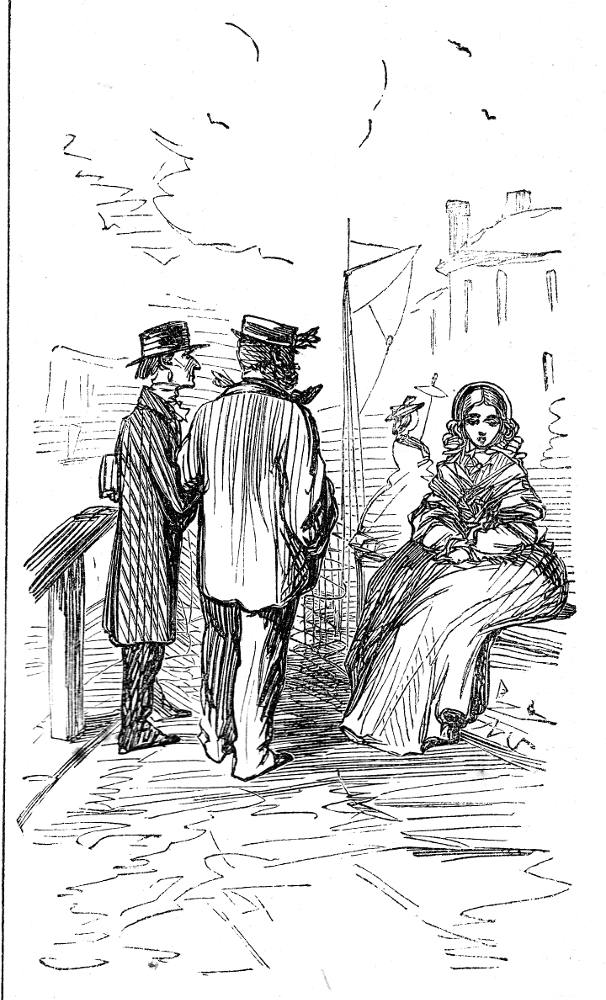

“Don't distress mamma about me,” she said. “Send for Norah.” Wood-engraving 11.3 cm high by 11.5 cm wide, or 4 ½ inches square, framed, for instalment forty-four in the American serialisation of Wilkie Collins’ No Name in Harper’s Weekly [Vol. VII. — No. 316] Number 44, “The Last Scene — Aaron’s Buildings.” Chapter I, plus a uncaptioned vignettte of Captain Kirke, buying a present in a toyshop (Chapter I: p. 37; p. 266 in volume): 9.5 cm high by 5.8 cm wide, or 3 ¼ inches high by 2 ¼ inches wide, vignetted. [Instalment No. 44 ends in the American magazine serialisation on page 39, at the end of Chapter II (page 272 in volume). The 17 January 1863 number in All the Year Round was number 45; number 44, containing only Chapter II, had appeared on 10 January 1863. The British serial wrapped up on 17 January 1863 with “The Last Scene,” Chapters III and IV.
Main Illustration: Magdalen, delirious in a deadly fever, attended by Captain Kirke
She had let her first floor to the lady a fortnight since. The lady had paid a week’s rent, and had given the name of Gray. She had been out from morning till night, for the first three days, and had come home again, on every occasion, with a wretchedly weary, disappointed look. The woman of the house had suspected that she was in hiding from her friends, under a false name; and that she had been vainly trying to raise money, or to get some employment, on the three days when she was out for so long, and when she looked so disappointed on coming home. However that might be, on the fourth day she had fallen ill, with shivering fits and hot fits, turn and turn about. On the fifth day she was worse; and on the sixth, she was too sleepy at one time, and too light-headed at another, to be spoken to. The chemist (who did the doctoring in those parts) had come and looked at her, and had said he thought it was a bad fever. He had left a “saline draught,” which the woman of the house had paid for out of her own pocket, and had administered without effect. She had ventured on searching the only box which the lady had brought with her; and had found nothing in it but a few necessary articles of linen — no dresses, no ornaments, not so much as the fragment of a letter which might help in discovering her friends. Between the risk of keeping her under these circumstances, and the barbarity of turning a sick woman into the street, the landlady herself had not hesitated. She would willingly have kept her tenant, on the chance of the lady’s recovery, and on the chance of her friends turning up. But not half an hour since, her husband — who never came near the house, except to take her money — had come to rob her of her little earnings, as usual. She had been obliged to tell him that no rent was in hand for the first floor, and that none was likely to be in hand until the lady recovered, or her friends found her. On hearing this, he had mercilessly insisted — well or ill — that the lady should go. There was the hospital to take her to; and if the hospital shut its doors, there was the workhouse to try next. If she was not out of the place in an hour’s time, he threatened to come back and take her out himself. His wife knew but too well that he was brute enough to be as good as his word; and no other choice had been left her but to do as she had done, for the sake of the lady herself. [“The Last Scene — Aaron’s Buildings,” Chapter I: p. 37; pp. 263-264 in volume]
Vignette Illustration: Kirke, Buying a Suitable Present for His Nephew in a Toyshop
He stopped once only on his way to the hotel to look at a toyshop in one of the great thoroughfares. The miniature ships in the window reminded him of his nephew. “My little name-sake will be sadly disappointed at not seeing me to-morrow,” he thought. “I must make it up to the boy by sending him something from his uncle.” He went into the shop and bought one of the ships. It was secured in a box, and packed and directed in his presence. He put a card on the deck of the miniature vessel before the cover of the box was nailed on, bearing this inscription: “A ship for the little sailor, with the big sailor’s love.” — “Children like to be written to, ma’am,” he said, apologetically, to the woman behind the counter. “Send the box as soon as you can — I am anxious the boy should get it to-morrow.” [“The Last Scene — Aaron’s Buildings,” Chapter I: p. 38; pp. 266-267 in volume]
Commentary: Results of Magdalen’s Machinations at St. Crux-in-the-Marsh and Afterward
When American serial readers had last encountered her in McLennan’s illustrations five weeks previously (13 December 1862), Magdalen disguised as the maid Louisa had been investigating the whereabouts and possible contents of Noel Vanstone’s putative “Secret Trust,” which Mrs. Lecount had intended to guide Admiral Bartram’s administration of the will. It has since become obvious in instalments 40 through 43 that the admiral’s nephew, George, must marry shortly or be cut off from the money resulting from the sale of the Comnbe-Raven estate.
But none of those instalments has even a single illustration, despite the fact that Collins provided plenty of suitable material, notably Admiral Bartram, “whispering without intermission” (Chapter IV, 253 in volume) as he is sleepwalking through the old Banqueting Hall as Magdalen searches in the middle of the night for the Secret Trust. Thus, we move in the Harper’s Weekly [Vol. VII, No. 316] instalment to Magdalen’s perilous health back in London after she has failed to secure her inheritance through her impersonation of the maid at Admiral Bartram’s. In our previous full-scale illustration (13 December 1862), we saw her serving the admiral and his “weather-beaten old man-servant,” Old Mazey, their after-dinner glass of Port in “West and by noathe, your honor.” (p. 239 in volume). We now jump over four unillustrated instalments and twenty-five pages in the volume to Captain Robert Kirke’s fortuitously rescuing her from her death-bed poverty in the London rooming house. The moment realised suggests her disconnection from her present reality as her mother has already been dead some time. McLennan’s dual portraits do justice to the form and character of the handsome young merchant sea captain who has just returned from China. In the final (unillustrated) instalment, the pair are married after the Secret Trust has turned up, and after George Bartram has married Norah Vanstone.

We had encountered this providential rescuer much earlier in the novel at Aldborough in the 23 August 1862 number: the uncaptioned vignette of Magdalen, sitting on the garden wall of The North Shingles Villa. At the conclusion of the previous serial number (10 January 1863), feeling sorry for her, even though he has caught her in the act of reading the purloined letter, abstracted with the admiral’s keys, Mazey lets her escape the great house. We are still not convinced that she has read in their entirety the key clauses in the Sacred Trust, but Collins has permitted us to understand that she is aware of the stipulation about George’s marrying. Now the present illustration of the feverish Magdalen in her bed at Aaron’s Buildings reveals that she had limited resources when she fled from St. Crux-in-the-Marsh, and that, having exhausted whatever cash she may have had, she gave notice at her respectable rooms in St. John’s Wood. The Admiral’s untimely death and the failure of the attorneys’ agents to discover the Secret Trust have served to reinforce the original terms of Noel Vanstone’s will, disinheriting Magdalen in her character as Mrs. Noel Vanstone entirely.
Related Material
- Wilkie Collins's No Name (1862): Charles Dickens, Sheridan’s The Rivals, and the Lost Franklin Expedition
- The Victorian Sensation Novel, 1860-1880 — “preaching to the nerves instead of the judgment”
Image scans and text by Philip V. Allingham. [You may use these images without prior permission for any scholarly or educational purpose as long as you (1) credit the person who scanned them and (2) link your document to this URL in a web document or cite the Victorian Web in a print one.]
Bibliography
Blain, Virginia. “Introduction” and “Explanatory Notes” to Wilkie Collins’s No Name. Oxford World's Classics. Oxford: Oxford University Press, 1986.
Collins, William Wilkie. No Name . Illustrated by John McLenan. Harper’s Weekly, Vol. VI. 15 March 1862-17 January 1863.
Collins, Wilkie. No Name [3 vols.]. London: Sampson & Low, 1862.
Collins, Wilkie. No Name [single-volume cheap edition]. With a frontispiece by John Everett Millais. London: Sampson & Low, 1864.
Collins, William Wilkie. No Name. Illustrated by John McLenan. [First American volume edition] New York: Harper & Bros., 1873.
Collins, William Wilkie. No Name. Illustrated by John McLenan. New York: Dover Publications, 1978.
Marshall, Gail. “Psychology and the Sensation Novel.” Victorian Fiction. London and New York: Oxford U. P. and Arnold, 2002. 57-63.
Vann, J. Don. "No Name in All the Year Round, 15 March 1862-17 January 1863." Victorian Novels in Serial. New York: Modern Language Association, 1985. 46-47.
Created 18 October 2025